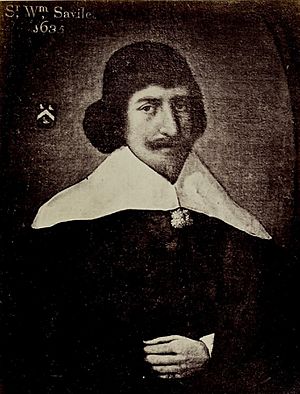Sir William Savile, 3rd Baronet facts for kids
Quick facts for kids
William Savile
|
|
|---|---|
 |
|
| 3rd Baronet of Thornhill | |
| Member of Parliament for Old Sarum |
|
| In office 1641–1642 |
|
| Member of the Short Parliament for Yorkshire | |
| In office 1640–1641 |
|
| Personal details | |
| Born | 1612 Thornhill, West Yorkshire |
| Died | 24 January 1644 (aged 31–32) |
| Children | 7, including George Savile, 1st Marquess of Halifax |
Sir William Savile, 3rd Baronet of Thornhill (born 1612 – died 24 January 1644) was an English politician. He served in the House of Commons, which is like today's Parliament, between 1640 and 1642. Sir William was a strong supporter of King Charles I during the English Civil War. He fought for the King's side, known as the Royalists, and sadly died in battle.
Contents
Early Life and Family Background
Sir William Savile was born in 1612 in Thornhill, West Yorkshire. His father was Sir George Savile, and his grandfather was also named Sir George Savile, the 1st Baronet. A "Baronet" is a special title, like a hereditary knight.
When his older brother George passed away in 1626, William inherited the title of 3rd Baronet. He also took over the family's large properties. These included Thornhill Hall, Rufford Abbey, and a house in the city of York.
Education and Early Career
William Savile went to University College, Oxford for his education. Later, in 1628, he joined Gray's Inn, which was a place where people studied law.
In 1633, he was chosen to be a Deputy Lieutenant for the West Riding area. This was an important local role, helping to keep order. By July 1636, he was also appointed to the King's council in the north of England.
Serving in Parliament
In April 1640, Sir William Savile was elected to be a Member of Parliament (MP) for Yorkshire. This Parliament was called the Short Parliament because it didn't last very long.
While in Parliament, he spoke out against "ship money," which was a tax the King tried to collect without Parliament's full approval. He also signed a petition against forcing soldiers to stay in private homes. Even though he disagreed with some of the King's actions, he remained loyal to King Charles I.
Moving to Old Sarum
Sir William lost his seat in the election of November 1640. However, he was elected again as an MP for Old Sarum in early 1641.
He continued to show his loyalty to the King. He even spoke in favor of a powerful royal advisor named Strafford during his trial. Sir William was briefly held in the Tower of London for a short time in June 1641, but he was released quickly.
When the King officially started the English Civil War by raising his flag in Nottingham on August 22, 1642, Sir William was right there with him. Because of his strong support for the King, Parliament decided he could no longer be an MP.
Fighting in the English Civil War
As the English Civil War began, Sir William Savile became an important military leader for the King's side.
Towards the end of 1642, he was put in charge of the town of Leeds. However, on January 23, 1643, the Parliamentarian forces, led by Fairfax, attacked Leeds fiercely. Sir William had to swim across the River Aire to escape when the town was captured.
Leading Royalist Forces
In May 1643, Sir William was made governor of the town of Sheffield and its strong fortress, Sheffield Castle. Later, he was moved to York.
In October 1643, he led the King's cavalry (soldiers on horseback) at the Battle of Winceby. Sir William Savile died in January 1644, fighting for the King near York.
He had turned his family home, Thornhill Hall, into a military base for the King's army. After Parliamentarian forces captured it, they sadly destroyed the hall.
Family Life
Sir William Savile married Anne Coventry on December 29, 1629. Anne was the daughter of Thomas Coventry, who was the 1st Baron Coventry.
Lady Anne became famous during the Civil War for her bravery. She was pregnant when Parliamentarian soldiers surrounded her in Sheffield Castle. She bravely defended the castle against cannon fire from all sides. Even though she ordered her soldiers to keep fighting, the castle was crumbling. The garrison eventually surrendered against her wishes. Lady Anne gave birth to her youngest child the very same night, on August 11, 1644.
Sir William and Lady Anne had seven children:
- Mary (born 1632)
- George (born 1633), who became the 4th Baronet after his father. He later received the special title of Marquess of Halifax.
- Anne (born 1634), who married Thomas Windsor, the 1st Earl of Plymouth.
- William (born 1635)
- Margaret (born 1640)
- Henry (born 1642)
- Talbot (born 1644), who was born during the siege of Sheffield Castle.
About eleven years after Sir William's death, Lady Anne married Sir Thomas Chicheley around 1655. They had two more sons together.

